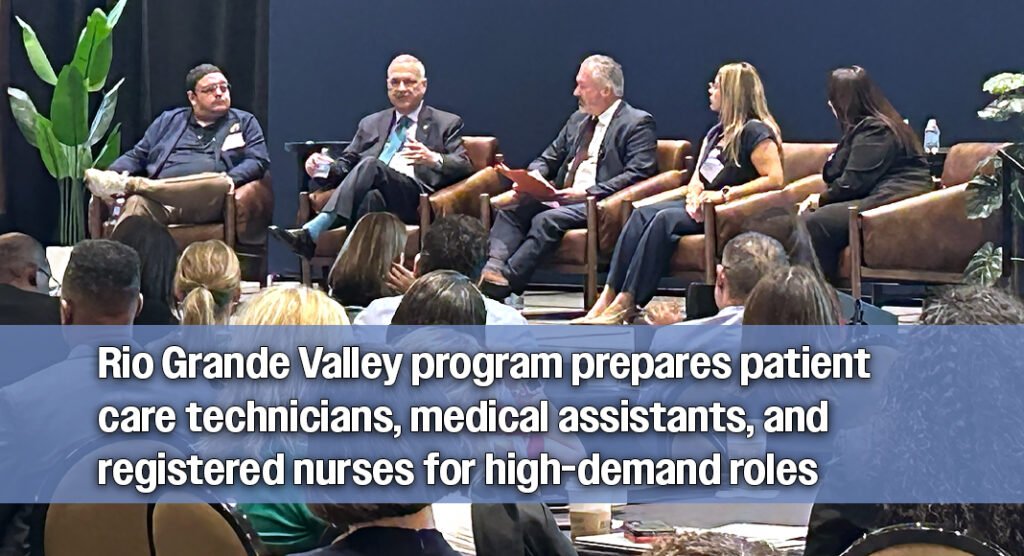Addressing Healthcare Workforce Challenges: Insights from the 9th Annual Apprenticeship Texas Conference
The healthcare industry in Texas is at a critical juncture, with a pressing need for skilled professionals. Recognizing this urgency, the 9th Annual Apprenticeship Texas Conference, hosted by the Texas Workforce Commission, took place on September 25, 2025, at the Sheraton Dallas Hotel. This year’s conference was themed “Building Texas Talent – Apprenticeships of Tomorrow,” focusing specifically on innovative strategies to develop a sustainable healthcare workforce.
Building a Healthier Workforce
One of the standout sessions of the conference was titled “Building a Healthier Workforce,” where panelists discussed the role of apprenticeship programs in mitigating healthcare shortages across the state. The emphasis was on fostering sustainable career pathways for workers in various healthcare roles.
Dr. Carlos Cardenas, Chairman of the Board at DHR Health in the Rio Grande Valley, played a pivotal role in this discussion. He shed light on the collaborative efforts between local educational institutions and health systems, which have culminated in successful earn-and-learn programs tailored for critical healthcare occupations.
“Much of our collaborative groundwork dates back several years,” Cardenas stated. “The establishment of these apprenticeship programs was a logical next step in building fruitful partnerships.”
Essential Healthcare Roles
The apprenticeship initiative aims to streamline the training for multiple high-demand positions, including:
- Patient Care Technicians
- Medical Assistants
- Registered Nurses
- Surgical Technologists
- Imaging Specialists
These roles are fundamental to ensuring seamless patient care, as they help bridge the gap between healthcare providers and patients. Registered nurses, in particular, are a focal point of the program, as they represent a significant workforce need in Texas hospitals today.
Funding and Measurable Outcomes
Securing funding is vital for the sustainability of the apprenticeship programs. Dr. Cardenas emphasized that ongoing support primarily hinges on measurable outcomes. The program is substantially funded through grants, but continuous efforts to secure additional funding sources are essential for its longevity.
“Grant support is crucial, but funders also want to see results,” Cardenas explained. “We are committed to being responsible stewards of the resources, showcasing clear returns on investment through measurable outcomes.”
Cross-Sector Collaboration
The panel discussion included notable figures such as Carlos Margo from South Texas College, Nori Zapata of DHR Health, nurse apprentice graduate Wendy Schell, and Joel Mario Ramos from Rio Grande Valley College. Their collective presence illustrated the importance of cross-sector partnerships in bolstering healthcare training initiatives.
These alliances between educational institutions, healthcare providers, and workforce boards are critical drivers of success. They ensure that education and training align closely with industry needs, thereby improving job readiness for graduates.
Replicability of the Rio Grande Valley Model
A significant takeaway from the conference was the replicability of the apprenticeship model established in the Rio Grande Valley. Dr. Cardenas expressed optimism about expanding this initiative to other regions, suggesting that similar efforts could be undertaken to address healthcare challenges elsewhere in Texas.
“What we have achieved here can certainly inspire solutions in other communities,” he affirmed. “This model not only tackles workforce shortages but also encourages individuals to pursue careers in healthcare—many of whom may not have considered such paths prior to participating in this program.”
The Future of Healthcare Apprenticeships
Overall, the discussions during the plenary session underscored that apprenticeship programs can provide scalable solutions to Texas’s healthcare workforce crisis. By developing professionals across various levels—from entry-level patient care technicians to licensed nurses—the initiative is designed to form a robust pipeline of healthcare professionals capable of meeting both immediate and long-term needs.
Conclusion
The 9th Annual Apprenticeship Texas Conference highlighted a vital strategy for addressing the workforce shortage in healthcare. With continued collaboration, funding, and innovative apprenticeship programs, Texas is poised to develop a healthier workforce equipped to handle the challenges of tomorrow.
For more insights on apprenticeship models and workforce development in healthcare, you can visit Texas Workforce Commission and learn more about their initiatives.
By focusing on the development of a skilled workforce, Texas is taking significant steps to ensure a healthy future for its residents and a thriving healthcare sector. Stay informed about similar initiatives and be part of the positive change in healthcare apprenticeship programs across the state.


